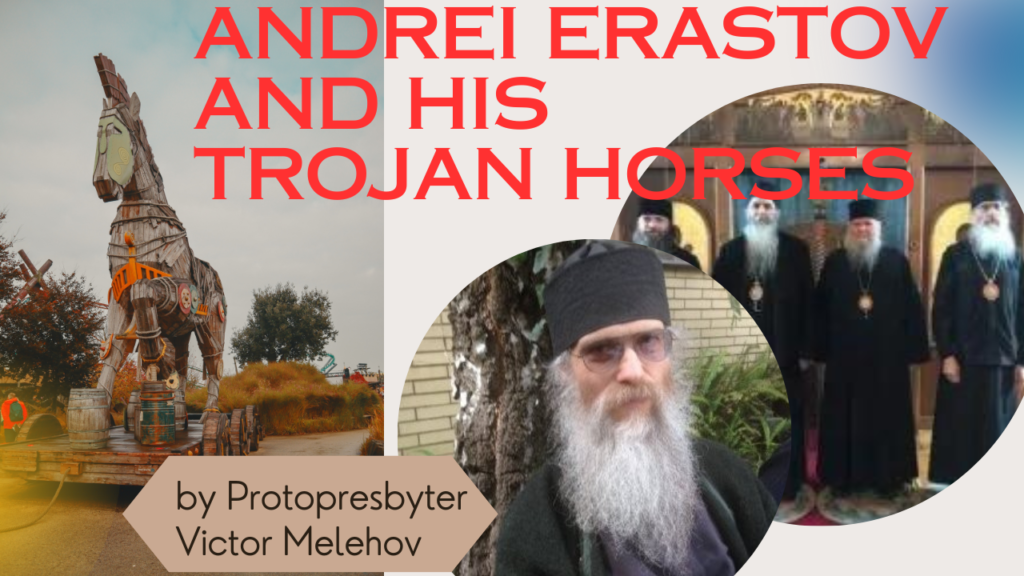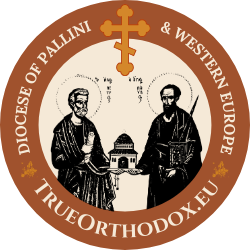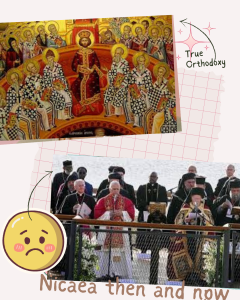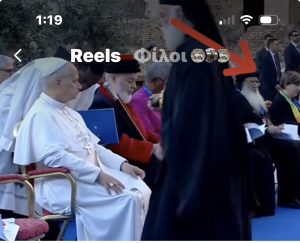ANDREI ERASTOV AND HIS TROJAN HORSES

Protopresbyter Victor Melehov
April, 2023
Several months ago, on the website of the “ROCA Diocese of Australia and New Zealand,” Bishop Andrei Erastov published an article titled “Trojan Horses,” where he makes some questionable and misleading statements. Although he admits grave canonical errors in the establishment of his new “religious group,” he offers no repentance for such transgressions. Justifying his own transgressions by blaming others is not a Christian virtue. Exalting oneself at the expense of others is the classic definition of pride. As he rallies his flock to appreciate the “freedom” he has achieved, either through ignorance or by design, by ignoring the counsel of the Holy Fathers and the canons of the Holy Church, he separates himself and his followers from them. Together with his group of simple monks, who by ignoring the same canons, could not maintain their episcopal status, Erastov has set the course to establish another splinter-sect. There are more than enough such vagrant “synods” parading about. Yet, if they lack (or lost) Apostolic Succession and an Orthodox canonical ecclesiology, these religious groups are simply sects with no connection to the Church. Regardless of external appearances, or degrees of education, such only become veiled hypocrites. Therefore, because what we have here is a schismatic pseudo-bishop who made himself the spiritual leader of parishes he beguiled and usurped rule over them from legitimate bishops with legitimate Apostolic Succession and a canonical Orthodox ecclesiology, this article begs a response. For if we keep quiet about such brazen deceptions, even “the stones will cry out.” (Luke 19:40)
As a founder of his newly formed organization without an administration, he admits his lack of canonicity as he summarizes his heroic leadership guiding his flock in their escape from the “canonical trap” they were tricked into by “agents of the KGB.” It was clear to him and his two colleagues (the other questionable bishops) that “there was no other way to escape this canonical trap if we were to conform to the letter of the canons.” This admission by itself says much more than the rest of his article. The Holy Canons were written by wise and caring holy fathers (many of them we recognized as saints of the Church) who applied canons/decisions of the past to solve the issues of their day, and then to provide pastoral guidance for the Orthodox Christians of the future. Those who ignore the canons, especially for their own benefit, ignore the Fathers of the Church, and break their continuity with them. This is a schism by itself, and one schism (if not corrected) will only breed another. Bishop Erastov summarizes his article as follows: “After 10 years of ordeal under their authority, we finally broke free to freedom as though from the clutches of robbers, although at the price of losing people, parishes and property. We broke out to freedom with the label of uncanonical schismatics, because there was no other way to escape this canonical trap if we were to conform to the letter of the canons.
Independent of one another and nearly simultaneously, a large section of clergy and laity departed from Metropolitan Agafangel’s and Archbishop Tikhon’s authority. A few months later, the Eucharistic communion was formed between Archbishop Andronik and Bishop Stefan, and following this in September 2017, the District Abroad was formed that contained both groups.
Now, at least let us try to be more circumspect so as not to repeat past mistakes. Above all else, we must value the freedom of our Church.
+Bishop Andrei”
Building up to such a conclusion, Bishop Erastov speaks of the history of the Russian Orthodox Church Abroad (ROCA or ROCOR) as being steadfast and strong in the Faith, as if he had some experience there. Yet, he arrived to the USA from the Soviet Union (USSR) as an 18-year-old teenager in 1978, to enter the Jordanville Seminary in 1979. This was the time of the 3rd wave when immigrant Soviet clergy and laity were infiltrating the ROCOR (ROCA) parishes and its monasteries. For the Jordanville Monastery and Seminary, these were its worst years yet. These were the years of its decline to its condition of today – a replica of contemporary monasteries of the Moscow Patriarchate.
The rest of Bishop Erastov’s article is dedicated to asserting the divisive work of the KGB through the bishops of two specific synods – the RTOC of Archbishop Tikhon and Bishop Agafangel’s ROCOR-A. Being raised in the USSR, one could expect that the bishop might be more familiar and knowledgeable regarding the work of the KGB. Yet, he should also know that it is common for people from the former Soviet Union to besmirch the reputation of others by accusing them of working with the KGB (or CIA) whenever they find such to be unpleasant. antipathetic, or repugnant.
Although he writes, “We are not asserting anything but only analyzing that which has occurred,” his “analysis” does produce some conclusive assertions. He glosses over the church history which he lived through for some 4 decades in order to convince the reader of some serious accusations and slander against specific individuals, as he attempts to justify his lack of canonicity and schism. Yet, other than his word that he knows the KGB does such things, he does not provide any substantive facts connecting the accused to the alleged crime.
So, let us begin by providing some facts. Let us begin by asking, who is Andrei Erastov?
(Please note: Searching the Internet, one can easily find all kinds of information – ranging from being extremely accurate to blatantly false. Therefore, if the reader finds certain facts to be inaccurate, the author would appreciate factual corrections.)
Is he a Soviet immigrant?
Dmitry Konstantinovich Erastov was born on February 1, 1960, in Moscow, USSR, into a family of educators – his father: Konstantine Olegovich Erastov (1939-1996), and his mother: Tatiana Danielova Tanhilevich (1938-)
In 1978, the 18 year old Dmitry received permanent permission to leave the Soviet Union and reside in the USA. In 1979 he became a resident of the Holy Trinity Monastery, Jordanville, NY, USA.
(It would be interesting to know for what merits this 18-year-old youth received permission and the opportunity to leave the Soviet Union, breaking out from under “tyrannical submission and persecution?”)
It needs to be noted that during the 1970’s a phenomenon called the “3rd Wave” of immigrants was allowed to leave the so-called “Iron Curtain,” where the Soviet Union kept its “citizens” under the tyrannical Communist rule of subjugation and persecution. No one was allowed to leave. Yet, this 3rd wave was the consequence of an arrangement the USSR made with the USA and Israel, where thousands of Soviet Jews would be allowed to leave for either country. At that time, it was reported that the USA would pay $2,000 for each person, as a reimbursement (ransom?) for the USSR’s loss. The 1st and 2nd waves were quite different. These waves took place during WWI and WWII, respectively. These waves consisted of those who could escape Soviet tyranny. During WWII, many who escaped were captured by the German military and placed into labor and concentration camps before being liberated. Others suffered their escape from this tyranny through China. Many died in their desire to be free. These people were refugees.
Furthermore, it needs to be noted that within this 3rd wave there was a number of Soviet (Moscow Patriarchate) clergy that were immediately received into the Russian Orthodox Church Outside of Russia (ROCOR), as well as others, like the young Dmitri Erastov, who immediately entered the Jordanville Seminary. By that time, the Jordanville Monastery/Seminary was not the same as it was earlier under Archbishop Averky, of blessed memory. To the contrary, much to the dismay of the Holy Hierarch, Metropolitan Philaret (Voznisenski), the Monastery/Seminary came under the control of the future apostate Bishop Laurus (later the Metropolitan of ROCOR).
As a child, I remember visiting Jordanville when it was still under the leadership of Archbishop Averky. The monks and founders of the Monastery came to the USA as refugees of the 1st and 2nd wave. The Monastery was not only a beacon of Faith, it was also a farm consisting of a herd of milk-cows, gardens, an apiary, a bakery, a cemetery, a printing press and a seminary. The monks there supported themselves and spiritually nourished the faithful.
For some anecdotal background information, in the summer of 1976, as a recently married couple on our cross-country wedding trip to Alaska, we stopped to visit the Jordanville Holy Trinity Monastery. There, I had a conversation with Bishop Laurus regarding whom I might contact in Alaska regarding finding and venerating the relics of St. Herman. Bishop Laurus recommended a good acquaintance of his, a young OCA priest on the island of Ouzinki. (The OCA had already received its autocephaly from the Moscow Patriarchate.) Seeing my surprise, he told me not to worry – after the old bishops die-off, he said, we will all be together.
Then, several years later in 1980, Bishop Gregory (Grabbe) confided in me saying, “We are already infiltrated (by the Moscow Patriarchate). We cannot weed them out without significant damage to the faithful of the Church.” Later, I was told that certain ROCOR bishops had convened in Europe to discuss church matters without the knowledge or presence of the First Hierarch, Metropolitan Philaret. Bishop Gregory and Metropolitan Philaret had considered separating from the rest of the Synod, but decided against it, thinking that at that time it might cause more harm than good. The Holy Hierarch Philaret reposed in 1985. Soon thereafter, the tenure of Metropolitan Vitaly began. By 1987, there were enough ecumenical concelebrations, trips to the Soviet Union for discussions and low-level concelebrations, all allowed and ignored by the ROCOR hierarchy to the extent that this caused a significant number of clergy, and parishes, along with several monasteries to leave ROCOR for canonical matters of Faith (i.e., Ecumenism and Sergianism). Most joined the TGOC Synod under Archbishop Auxentios, who received them canonically for reasons of Faith. Clergy awaiting union with the Moscow Patriarchate celebrated this departure, publishing statements expressing their joy at being rid of Metropolitan Philaret, Bishop Gregory (Grabbe) and their followers.
Immediately, ROCOR brought lawsuits against two such parishes, the Church of St. John the Russian in Ipswich, MA, USA, and the Church of the Holy Resurrection in Worcester, MA, USA, which today is the Synodal Podvorie of the Russian True Orthodox Church and the corporate offices of the True Orthodox Church, as registered in the USA.
The Parish of the Church of the Holy Resurrection endured an 8-year lawsuit brought on by ROCOR in an attempt to seize the Worcester Parish property and to financially stifle its witness for the Faith. This lawsuit finally ended with a decision in its favor by the United States Supreme Court. As Rector of this parish, I insisted that ROCOR was headed for union with the Soviet Church (MP), and that (along with the Ecumenism that comes with it) was our sole reason for leaving ROCOR. As part of our discovery process (1988-1989), we requested (under the Freedom of Information Act) all records of correspondence between ROCOR and the Moscow Patriarchate, the KGB, and individuals in the Soviet Union, including the Soviet Government, which might be kept by the FBI or CIA. We received a good number of documents, with most of them extensively redacted. One confirming comment coming from the FBI was that the agency no longer viewed ROCOR as they did before. They no longer viewed it as an anti-Soviet corporation that they could trust. In other words, Bishop Gregory was quite correct when he said that ROCOR was already infiltrated in 1980.
By 1994, those who left in 1987 found themselves justified. During its 1994 Sobor, ROCOR formally adopted the heretical ecclesiology of the Cyprianites. (This, by itself, was sufficient reason to leave such bishops.) In other words, the Mother Church (the Moscow Patriarchate along with all the “World Orthodox” New Calendarists) was “ill, but it still had Grace.” Of course, this was overshadowed by the glorification of the Holy Hierarch and Archbishop John of San Francisco and Shanghai. Few (including bishops and clergy) understood the significance of this new recognition of the Cyprianites (the deposed Greek “Synod in Resistance”). However, now ROCOR was on a direct path to the MP. Its new ecclesiology justified it. It could now heal the ailing Mother Church (Moscow Patriarchate) by joining and working from within. Indeed, a lofty goal, if one can envision healing the Church! Any sober-minded Orthodox Christian would immediately reject such a pride-soaked heretical thought. Why? Does not the Church heal us? The Church cannot be sick. If such a church body is infected with heresy (i.e., Ecumenism, Sergianism, etc.), it is no longer the Church.
Only one of the ROCOR bishops understood this. The forcibly retired theologian of ROCOR, who helped guide ROCOR through the tenures of three Metropolitans (Met. Anthony, Met. Anastasi, Met. St. Philaret), Bishop Gregory (Grabbe) wrote the following:
“………I have been given the opportunity to acquaint myself with several letters written by one of the bishops of Metropolitan Cyprian’s group. From these it is quite evident that he and his fellow bishops confess their own personal, and in no wise Orthodox, doctrine concerning the possibility of the Grace-filled activity of the Holy Spirit within churches which have become manifestly heretical. ALL the New Calendarists – without the least exception – are likewise very active Ecumenists.[9] The Old Style Churches (Russian and Serbian) have for a long time now also confessed this very same heresy. But behold, this hierarch of Metropolitan Cyprian’s group insists on the opinion that, so he says, “the New Calendarists, besieged by the heresy of Ecumenism and Innovation, have not been deprived of Grace,[10] or at any rate, it is not within our competency to make such a pronouncement on our part … we are not speaking of union with Belial, but (only) with those ailing in faith, several of whom are in need of spiritual treatment … in view of this, we do not totally break off communion with them.” [11] In another letter the same hierarch expresses the thought – totally unacceptable and absurd from a dogmatic point of view and from that of the Holy Fathers – that this group, while recognizing that the Ecumenists have Grace, is only “walling itself off from their errors.” In pronouncing its Decision concerning communion with Metropolitan Cyprian’s group, our Sobor, unfortunately, did not also call to mind the text of that Decision taken formerly, under the presidency of Metropolitan Philaret, anathematizing the heresy of Ecumenism. Among others it contains such words as these *”Therefore, to those who knowingly have communion with these aforementioned heretics, or who advocate, disseminate, or defend their new heresy of Ecumenism: Anathema.” *[12] Indeed, by not investigating the matter seriously and by forgetting about this previously confirmed anathematizing of the New Calendarists/Ecumenists (or perhaps not venturing to abrogate this resolution), our Sobor, as frightful as it may be to admit, has fallen under its own Anathema. Had it probed the net spread before it more carefully, it would never have issued such a contradictory Decision.
Our previous Bishops’ Sobors never raised the particular question concerning whether or not the New Calendarists have Grace. But the fact that formerly concelebrations with them were never permitted already testifies with sufficient clarity that the Church Abroad considered them to be without Grace. Must we consider that our Synod has entered upon the path of betrayal of the traditions of the Holy Fathers, or did it merely commit an error owing to poor judgment which it is still not too late to correct at the next session of the Sobor to be held in November in France?[13]
Bishop GREGORY
Of course, it is now 2023. That “path of betrayal” was taken 3 decades ago. Instead of making Bishop Gregory’s suggested correction, ROCOR took the path to apostasy.
Is he a Jordanville graduate, monk, iconographer, and hieromonk?
Dmitry Konstantinovish Erastov graduated from the Holy Trinity Seminary in 1982, becoming an accomplished iconographer. In 1985, he took the monastic tonsure (apparently with the name of Andrei). By 1989 he was ordained a hierodeacon, and in 1993, he was ordained a hieromonk. For the glorification of St. John of Shanghai and the 1994 Sobor, he painted the icon of St. John. Although it is not easily confirmed, it can be reasonably assumed that he was present at that glorification, as were the Cyprianite clergy, being special guests of honor. Along with all the other clergy present at that sobor, to date, nothing has been heard from the hieromonk Andrei Erastov regarding the heresy accepted by the participants of that sobor. Remaining at the Jordanville Monastery/Seminary, hieromonk Andrei taught Church Slavonic and iconography.
Is he a confessor of the Faith?
Apparently hieromonk Andrei was not willing to accept the upcoming union between ROCOR and the Moscow Patriachate. He left his monastery in Jordanville, as well as ROCOR altogether to join the Greek Lamian Synod (under Archbishop Makarios) as their clergyman in France (under the Lamian Bishop Philaret). (The Lamian Synod was formed by two bishops (Metropolitan Kallinikos (Haniotis) of Phthiotis and Thavmakos (Lamia area). and Metropolitan of Thessaloniki, Euthymios (Orphanos)) who left the TGOC (headed by Archbishop Chrysostom) in 1995 in order to avoid an investigation by the TGOC of their possible homosexual behavior.) It is interesting to note that hieromonk Andrei’s reasons for leaving his monastery, and his ROCOR bishop, as well as the reason for the Lamian Synod to receive him, are nowhere to be found. Also, there is no record of any disciplinary action undertaken by ROCOR for his departure. Was it for matters of Faith? Was it canonical? Was he given a canonical release from his ROCOR bishop to join a schismatic synod? Did the Lamian Synod not require him to reject his acquired Cyprianite heresy?
Then, in 2009, hieromonk Andrei left the Lamian Synod to join the newly formed synod of Bishop Agafangel (Pashkovsky). He was assigned to serve in Australia. Once again, no apparent reason given for leaving or joining. Once again, no confession of Faith, no statement of ecclesiology from either Erastov or Pashkovsky. To the contrary, at one of his clergy meetings, when asked about Cyprianism, Bishop Agafangel proclaimed, “I am a Cyprianite!” It must be noted that Bishop Agafangel has become known for his ignorance of Orthodox ecclesiology. For example, as a young ROCOR bishop in Ukraine, in direct contradiction to the decision of the 1971 ROCOR Sobor under St. Met. Philaret, in his own publication, Bishop Agafangel wrote:
“…the Grace of the Holy Spirit, the Grace of the Sacraments, resides also with the Catholics, Monophysites, and in part, with Old Believers and Protestants who have not violated the formula in performing the sacraments (baptism). The Orthodox Church does not re-baptize those who come from these heresies, but receives them through repentance. Catholics and Monophysites are not chrismated a second time. The Sacrament of Marriage is also accepted. In the Moscow Patriarchate, there are six Sacraments which have been preserved and are recognized as valid – baptism, chrismation, the priesthood, marriage, unction, repentance.”
(Bishop Aganfangel Pashkovsky, Vestnik TOC, No. 2, 1994, pg. 30)
To date, Bishop Agafangel has not retracted the above.
In 2011, hieromonk Andrei was awarded the rank of igumen (abbot) by the Agafangel Synod. Although Igumen Andrei is said to be an accomplished iconographer, one cannot say he is known for his knowledge of, or concern for, Orthodox ecclesiology. He has not shown himself to be a confessor of the Faith.
Having stated the facts above regarding Bishop Erastov, let us review some more facts regarding Bishop Agafangel.
Bishop Agafangel is from Odessa, Ukraine. He knew Archbishop Lazar, Archbishop Benjamin and their clergy rather well. He was sent by them to represent their objection to the impending union with the MP before the ROCOR Synod of Bishops in the USA. He betrayed his fellow bishops and clergy. Bishop Agafangel pledged his allegiance to the new Metropolitan of ROCOR, Laurus, and his new direction toward union with the Soviet Church. So, in addition to his Ecumenist and Cyprianite ecclesiology, Bishop Agafangel became a sojourner with ROCOR’s Synod of Bishops toward Sergianism.
Yet, all of a sudden, literally at the 11th hour before the ROCOR-MP union in 2007, Bishop Agafangel decided to leave Laurus’ ROCOR, and form his own. He stated that he was not against union with the MP. For him, it was just too early at that point in time.
As one of the clergy mutually with Archbishop Lazar in the past, Archbishop Tikhon (RTOC) extended an invitation to Bishop Agafangel to begin a possible dialogue. Bishop Agafangel rejected this offer and stated that anyone who left ROCOR before him was to be considered a schismatic – another profound statement issued without thought. Did he actually want to include Metropolitan Vitaly, who left his false brethren-bishops in 2001? Instead, Bishop Agafangel plotted to restore ROCOR’s hierarchy by claiming that the retired Bishop Daniel of Erie supported his plan. When Bishop Daniel discovered B. Agafangel’s plot, he quickly rejected any rumors of his participation or agreement with it.
Soon thereafter, Bishop Agafangel appealed to the Greek “Synod in Resistance” (the original
Cyprianites) whose ecclesiology was accepted by the ROCOR Sobor in 1994. This synod was deposed along with their heresy, and declared to be without Apostolic Succession, twice by the Synod of TGOC, the synod from which they split – the first time under Archbishop Auxentios and the second time under Archbishop Chrysostom. These Cyprianites agreed to Bishop Agafangel’s request, and proceeded to help him restore his new ROCOR-A by ordaining bishops. Every one of ROCOR-A’s new bishops was ordained with concelebrating Cyprianite bishops.
Whether he understood it, or not, Bishop Agafangel entered a schism by uniting and concelebrating with deposed schismatic bishops (simple monks). This, by itself places every bishop, priest or deacon ordained in ROCOR-A into a questionable situation regarding their Apostolic Succession and canonicity. Furthermore, by rejecting all the anti-MP synods of the Russian Church, and appealing to Greek Church schismatics, Bishop Agafangel created a schism with the Russian Church. In 2009, Hieromonk Andrei Erastov, having left the Lamian schism in France, willingly joined the ROCOR-A schism. Is it possible that the hieromonk had no knowledge of the heretical, canonical, and schismatic mess he then accepted as the Church, only to say some 15 years later that he was trapped?
It needs to be noted that much later (after becoming a metropolitan), Bishop Agafangel announced that it was possible to enter into dialogue towards union with any Russian synod, except for one – the RTOC.
Of course, as stated before, one schism usually leads to another. In 2007, Hieromonk Andronik Kotliaroff was the first of Agafangel’s candidates to be ordained bishop. Today, he is also one of those who claims to have been trapped, thereby needing to ignore the canons in order to be “free.” Yet, he held-off his schism until 2017. He was even promoted to the rank of Archbishop by the synod of ROCOR-A, as did his co-schismatic Archbishop Sophroni of St. Petersburg, Russia. There is more than enough written about this schism, and none of it rises to any legitimate canonical level. It amounts to an ugly administrative dispute by two bishops who refused to be subordinate to a synod they recently joined of their own free will, which resulted in their deposition to the rank of simple monastics. Sad to witness, but the simple monk Andronik continues to make the weak argument that their departure from ROCOR-A was canonical. (See his interview with PortalCredo on his own website.) One might imagine him finding some enlightenment and closure in the recent Erastov article.
In conclusion to my commentary on this part of the Erastov article, one might consider that even if the KGB had a specific vested interest in the humiliation of the ROCOR-A synod, or Erastov’s group, their church life along with their clergy, the KGB might have decided to let them be. After all, why waste time and treasure pursuing something that is already transpiring by itself? Who would have thought it possible to confuse people to the extent where they might believe that any of this kaleidoscopic confusion could be seriously considered to be the continuation of the real ROCOR/ROCA of old? A synod with no administration, designed to provide example and guidance for the last times? A synod of simple monks, who could not maintain their former episcopal rank (within a synod they willfully chose), now “ordaining” more clergy, including a “bishop?” Finally, if one still wishes to follow conspiracy theories, true or false, one can find articles on the internet revealing the CIA/FBI contacts (with names) that were allegedly close to Bishop Agafangel, and who are said to have aided him with the organization of his ROCOR-A. Who knows? Perhaps this is more credible than Erastov’s KGB accusations?
Regarding the formation of the RTOC, there is no confusion, no underhanded or unscrupulous behavior, and certainly no trickery leading to a “trap.” There is no KGB connection. After the ROCOR Synod’s intention to unite with the Moscow Patriarchate, Archbishop Lazar and Archbishop Benjamin, two ruling (not retired) bishops of the ROCOR, within Russia, decided to wall themselves off and continue with their own synod (RTOC), in the tradition and ecclesiology of the pre-Laurus ROCOR. Under the circumstances, the RTOC was a very canonical and necessary move for the continuation of the Church and the salvation of those within it. Regarding the former Bishop Stefan of the RTOC, it is true that Archbishop Tikhon visited the USA, Australia, and other places, where he offered the RTOC’s assistance in re-establishing the Russian Church аbroad. In the USA, the candidacy of the Archpriest Stefan Sabelnik was offered by the clergy and faithful that gathered. The RTOC agreed, and in 2007, Fr. Stefan was tonsured and ordained to the dignity and rank of bishop. He was placed in charge of Trenton, NJ, and North America. Bishop Stefan, the clergy and faithful within the USA were promised the RTOC’s cooperation and support of establishing an independent church administration, while remaining in communion as sister-synods. The understanding was that Bishop Stefan, residing in the USA, was responsible for proposing suitable candidates toward this end. Unfortunately, for an entire decade, not one candidate was proposed.
The former Bishop Stefan did have a long-standing friendship with the former Bishop Andronik. They had a common background, which both of them valued, in that both were alumni of the Jordanville Seminary. Although Bishop Stefan spoke of uniting with Bishop Andronik, he understood the RTOC’s position regarding Bishop Andronik’s questionable ordination and lack of canonicity. He understood that if he would unite with Bishop Andronik, the RTOC Synod would accept this only under the condition that Bishop Andronik accept heirotesia – a laying on of hands to correct his previous consecration. Bishop Stefan understood that Bishop Andronik would not accept this.
With time Bishop Stefan began accusing the RTOC Synod of lacking sobornost. It should be known that Bishop Stefan was invited to every meeting of the RTOC Synod every year of his tenure as a bishop. Except for his consecration in 2007, he never attended one Synod meeting. His excuse was always the distance, and his health. Nonetheless, he was informed in writing of the decisions of these Synod meetings, and was regularly asked for his input. What he meant by his accusation was never explained with any clarity.
The Erastov article attributes the following to Bishop Stefan’s complaints:
“We sensed we were tricked. We felt that these Bishops were not what they made out to be – that they are fraudsters. They were of an alien spirit, MP spirit, although camouflaged in a True-Orthodox rhetoric. This was expressed admirably by Bishop Stefan (Sabelnik) when addressing the RTOC Bishops: “You cannot be Bishops of the True Church because you lie”.”
Let us assume that “this was expressed admirably…” Between these two accusations (the “lack of sobornost” and “you lie”), can one find a canonical reason for abandoning one’s synod of bishops to form a questionable quasi-union with a seminary friend, and a less-known individual still residing in the former Soviet Union (especially with no further explanation of either accusation)? As a result of his uncanonical departure and creating a schism through uniting with other schismatics, Bishop Stefan Sabelnik was defrocked by the RTOC Synod of Bishops in 2018, and reduced to the rank of simple monk. And once again, one schism leads to another.
This quasi-synod formed by 3 simple monks soon made a decision. They decided to consecrate the Igumen Andrei Erastov to the rank of a bishop, assigned to Australia. The monk Stefan could not attend. He died that year. The other two followed through with their decision.
Once again, Andrei Erastov steps-in and joins an even more questionable, uncanonical and schismatic group. Yet this time, he is hardly alone. He managed to deceive and usurp power over a significant number of clergy and laity from our Australian flock.
Finally, the pseudo-bishop Erastov’s attempted explanation, as to why so many ROCOR/ROCA synods have spawned after the ROCOR-MP union, begs some commentary.
He writes:
“Over a sequence of years, ROCA enjoyed a conviction in its exclusiveness since at that time ROCA firmly adhered to pure Orthodoxy while the other Churches, in one way or another, deviated from it. Thus, in the minds of Her parishioners, standing in truth equated to belonging to ROCA. Gradually, the concept of the one true jurisdiction was born, to which one must belong in order to be among those who are being saved.
The misconception here lies in that the understanding of the Church as such is being substituted with the understanding of jurisdiction, i.e. the administrative church structure.
When, after 2007, these parishioners found themselves in different Synods, the comprehension of true jurisdiction was carried over to their own group. Hence the surprising phenomenon that the members of the one ROCA, began to regard only themselves as belonging to the Church while their fellow brothers and sisters who found themselves in another Church jurisdiction, were declared schismatics and renegades.
However, apart from the spiritual-psychological reasons, there are without a doubt, external causes for our fragmentation. There is a noticeable presence of an evil mind, intent on fostering a division among us into hostile groups and supporting this animosity.
Experience has shown that with the presence of a disposition toward unification on the part of the primates of the Church groups, there is no opposition from those beneath, and all preconceptions are quickly overcome. From this, it can be seen that the true reason for our division is the lack of goodwill toward unification among the First Hierarchs of the ROCA groups. These Hierarchs brazenly exploit the above-mentioned parishioners’ preconception, proclaiming that their group is solely grace-filled and salvific.”
Well, at least we see an attempt at defining the problem, simplistic as it sounds: Let’s put all our
“splinter” problems into a “spiritual-psychological” box, in which we can blame the herd-effect of the laity conditioned “over a sequence of years,” and couple this with blaming the “brazen” “First Hierarchs” who are exploiting their parishioners’ preconceptions, or riding herd over them. And, then what? What is the solution? Perhaps we might de-zombify the laity and send the First Hierarchs to sensitivity/anger management sessions? Or, just ignore the canons and we can be free? Better yet, if Bishop Erastov studies his “splinter” problem more circumspectly, he might uncover another military metaphor: “We have met the enemy and he is us!”
To properly analyze this so-called “phenomenom,” let’s first ask the obvious question: Who are these “First Hierarchs,” and what do they have in common? We have Archbishop Tikhon (RTOC), Metropolitan Theodore (ROAC), Bishop Agafangel (ROCOR-A), Bishop Vladimir Tseleshchev (ROCOR-VV), the headless group of Andronik, Sophroni, and Andrei (ROCA-A-ASA), along with several other ROCOR pretenders with few followers.
The first two synods RTOC and ROAC are independent synods of the Russian Church in Russia with comparable ecclesiologies. Although a few major differences exist, these synods and their first hierarchs are not involved with the issues attempted to be defined in the Erastov article. The rest are all obviously vying to be the new ROCOR/ROCA.
Aside from their desire to create a new ROCOR, what else do they have in common? All of them except for one (Andronik) have come to ROCOR in its turbulent and waning years. From where have they come? From the 3rd wave to the 4th, they have come from the Soviet Union (USSR), or from the Post-Soviet Russian Federation/Ukraine. So, what do they know of ROCOR? Is it only that ROCOR was not the MP? Perhaps it was just a cleaner, less ailing, part of the Church? We all know that we have heard such opinion before. So, what might be their vision in restoring it? Do they want the ROCOR of St. Met. Philaret, or Met. Anastasi, or Met. Anthony? How about the ROCOR of Met. Vitaly? As much as Met. Vitaly struggled against his Soviet-minded false- brethren-bishops, he was already out-numbered. The Judas/Laurus had already sold that which could not be valued.
Except for one (Bishop Vladimir who rejected Cyprianism in writing), all of the above ROCOR- want-to-be bishops have accepted Cyprianism to be ROCOR’s ecclesiology since 1994, and since have openly supported it. It needs to be noted that in accepting the Cyprianite ecclesiology, they have rejected ROCOR’s anathema against Ecumenism, as do all Cyprianites. Naturally, one cannot serve God and Mammon. It should also be noted that Andronik has gone on record publicly proclaiming that since the author of the Cyprianite ecclesiology (Met. Cyprian of Oropos and Fili) is dead, his Cyprianite ecclesiology is dead too. Of course, Andronik did not, thereby, go on record rejecting this ecclesiology. But, according to the patristic definition, we know that heresy is rejected not by ignoring it, but by its public condemnation, which we do not expect from Andronik. The truth here is that these Soviet/Post-Soviet bishops do not know what to do. Yet, it does appear that all of them would not mind being First Hierarch of all First Hierarchs. The other truth, which does not seem to interest them, is that the real ROCOR always had an ecclesiology based upon the Holy Canons, which served the needs of the Church through all the years. (i.e., the 1983 anathema against Ecumenism, and other such decisions needed to address issues affecting the Church and flock, etc.) Being a graduate of the Jordanville Seminary has little meaning, or use, if the graduate does not know or understand this.
Indeed, the real ROCOR considered adhering to the holy canons as being of the utmost of importance. Perhaps foreseeing what might be after ROCOR’s betrayal, the Holy Hierarch Metropolitan Philaret had left us the following instructions:
On the Significance of the Canons in Church Life
“… Holy Scripture says: every man is a lie, every man is a liar. This does not mean that a person lies at every step and that he deliberately lies, but that every person makes mistakes. Man’s sin has poisoned and corrupted his mind, so it is natural for every man to err. And even in his best impulses, even in his holy, good aspirations, sin still does its job and poisons it, introduces irregularities, as the Holy Fathers have warned us.
Yet, there is an unconditional and eternal authority – this is the Church and Her holy laws, and one should never allow the thought of putting the canons of the Church and sacred rules aside and solving some important issues without them. By no means. This is one eternally unshakable and absolute truth: the Holy Church rules and canons. They do not pressure us. No. But they show us exactly the path we need to take. And no earthly conditions, no current conditions, even if after us conditions become worse, even more difficult, still this will never give the right to the true children of the Church to say that now it is impossible to be guided by the canons. God forbid! If only we allow this, that partition will immediately collapse, that barrier by which the Church is separated from what is outside, then everything will perish. The Church can be covered with blood, persecuted as much as you like, but no force can change in Her those laws by which She lives.
No personal trials, no matter how sincere, holy, lofty and spiritual, may be entirely relied upon as the last authority, but one should always remember that the Holy Church canons are the highest authority, on which a person should always orient himself, especially where he wants to reform life for the better in the spiritual sense. This is what I wanted to warn you about.”
Metropolitan Philaret (Translated from the Russian – Conversations Regarding Church Truth, Orthodox Russia, 1994, No 19. C. 4.) Is it possible to find such pastoral wisdom and spiritual instruction in any of the present splinter- synods vying to be the ROCOR? To the contrary, these so-called bishops, through their own actions and confession, have already managed to create that “collapse” of which our holy Confessor St. Philaret so wisely warned. By ignoring the advice of such holy hierarchs of the true ROCOR, they have generated multiple schisms, and have adhered to heresy (Cyprianism, or Crypto-Ecumensim), thereby collapsing “that barrier by which the Church is separated from what is outside…”
The over-riding truth, which said bishops either ignore, or do not understand, is that the real ROCOR had a mission and a duty to fulfill. That mission was to nurture and keep the Holy Orthodox Faith Abroad until such time that it could freely reunite with the Russian Orthodox Church inside Russia, and then help restore what is needed. This Russian Orthodox Church inside Russia is not Joseph Stalin’s Moscow Patriarchate. Rather, it is that persecuted Church of the New Martyrs and Confessors of Russia. That same Russian Orthodox Church which was forced to exist in the catacombs, and become more popularly known as the Catacomb Church in Russia. So, perhaps to the surprise of many, and the dismay of some, this reunion has already taken place. Indeed, while the apostate Laurus was dragging his dying ROCOR to drop dead at the feet of his Master Apostate and Sergianist, the Patriarch of Stalin’s Church, the free ROCOR, albeit small and hardly noticed, had already fulfilled its mission.
The ROCOR Synod of Bishops under the guidance of St. Metropolitan Philaret already then had lines of communication with catacomb groups in the Soviet Union. Through these communications the Synod was able to consecrate Bishop Lazar (Zhurbenko), and later, Bishop Benjamin (Rusalenko). Both of these hierarchs of ROCOR were inside the territory of the Soviet Union. They continued to serve their flock in the Catacomb Church. After the Soviet Union broke apart in 1991, they were able to come out of the catacombs and establish their Cathedral of St. John of Kronstadt in Odessa. After the determination of Laurus’ ROCOR Synod to unite with the Moscow Patriarchate, these same two ruling (not retired) bishops decided to canonically withdraw from their false-brethren-bishops, and along with a blessing from Metropolitan Vitaly, who came out of retirement during this period of crisis, the ROCOR’s mission was fulfilled through the RTOC.
So, the news to all who wish to be the ROCOR (or ROCA): the ROCOR we knew is no more, and no Soviet/Post-Soviet immigrants are able to resurrect it. To those who wish to argue and gainsay this fact, just answer the question: If you contend (or pretend?) to be the Russian Orthodox Church Outside of Russia (or the Russian Orthodox Church Abroad), where is your Russian Orthodox Church inside of Russia? A sail, or rudder, without the Ark serves little purpose. If such is the case, then indeed you may be a “splinter,” but you are not the Church.
It has long been a Soviet tactic to accuse others of what one is guilty and doing himself. Modern western politicians have learned this quite well. So, they accuse someone of something that might be impossible to prove otherwise. For example, a person is asked by an interrogator: “Tell me the truth! When was it that you stopped beating your wife?” The person responds: “I have never beaten my wife!” Interrogator: “Answer the question! When did you stop beating your wife?” And so, it continues in a different form: “Because of such behavior and actions of that sort, you must be an agent of the KGB, or at least controlled by them!” As one Soviet tyrant once said, “Keep repeating a lie, and soon people will start believing it.”
So, when we find the 2-monk-ordained bishop Erastov from the Soviet Union railing against Archbishop Tikhon and comparing him to the hapless Bishop Agafangel, while accusing both of collaborating with the KGB and then mystically injecting a third co-conspirator with an over- riding “evil mind,” (“There is a noticeable presence of an evil mind, intent on fostering a division among us into hostile groups and supporting this animosity.”), one’s curiosity awakens. Of whom does he speak? What is he talking about? Perhaps time will tell.
The pseudo-bishop Andrei Erastov writes much but says very little. Yet, the very little could be very revealing. Might it be that Andrei Erastov is actually the Trojan Horse?
“Who hath ears to hear, let him hear.” (Matt. 13:9)







Le hiéromoine Andrei Erastov n’a pas ”quitté” la métropole française (Mgr Philarète) du synode lamiaque de Mgr Makarios de son plein gré. Après son bref passage chez nous en effet, il a été constaté qu’il faisait communier des personnes d’orthodoxie douteuse, notamment des gens du ”patriarcat” ; après avoir été repris à plusieurs reprises par Mgr Philarète, il a persévéré dans sa position hétérodoxe. Mgr Philarète lui a donc soumis une profession de foi orthodoxe, qu’il a refusé de signer. Mgr Philarète lui a donc fait comprendre qu’il devait quitter notre synode. Mais mon évêque, à qui je vais dès aujourd’hui signaler votre article, vous racontera tout cela mieux que moi (s’il le juge nécessaire)…
Merci beaucoup!